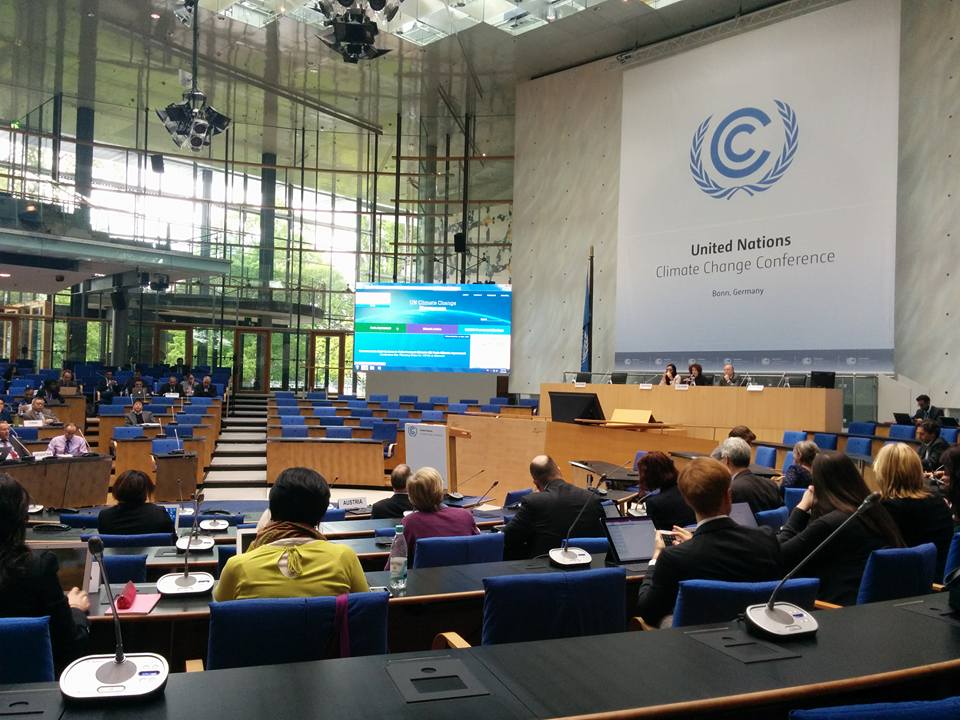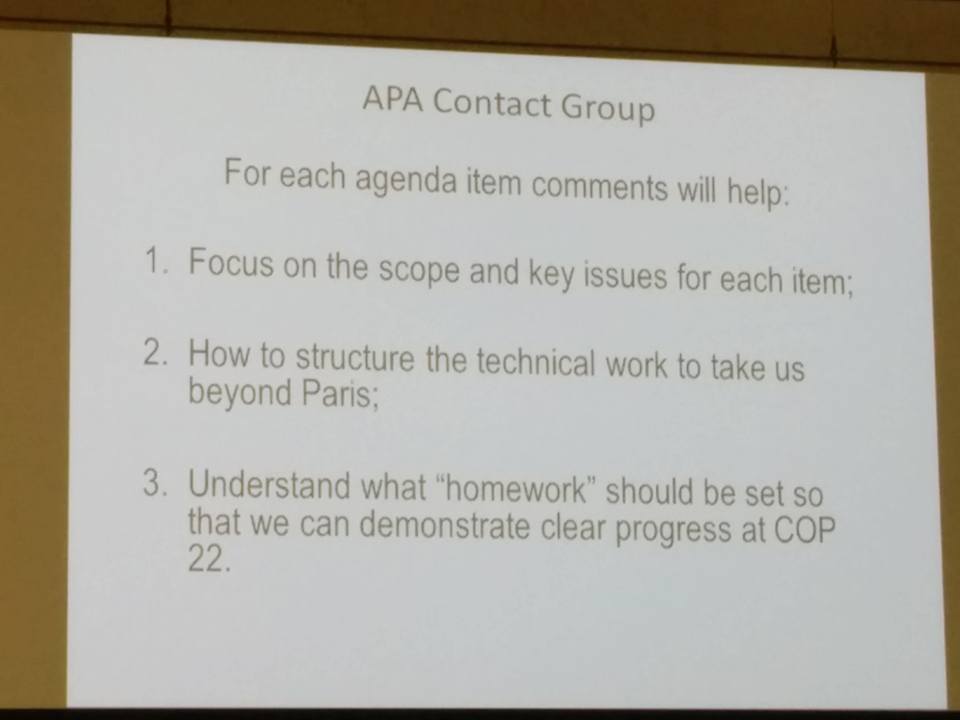Bonn Climate Change Conference
Bonn – Climate Change Conference 16-26 May 2016
Climate change negotiations resumed in Bonn on 16 May 2016, just a few months after the conclusion of COP21 in Paris. The Bonn meeting comprised the 44th sessions of the Subsidiary Body for Implementation (SBI 44) and Subsidiary Body for Scientific and Technological Advice (SBSTA 44), as well as the first session of the Ad Hoc Working Group on the Paris Agreement (APA 1).
The agenda of SBI included: reporting; matters related to the Kyoto Protocol’s mechanisms; least developed countries; national adaptation plans; third review of the Adaptation Fund; capacity building; response measures; and gender. The SBSTA programme of work included: the Nairobi work programme; agriculture; science and review; response measures; methodological issues under the Convention and the Kyoto Protocol; and market and non-market mechanisms.
In addition to the usual meetings of the SBI and SBSTA the May session also hosted the first meeting of the APA, a new subsidiary body established by the Paris Agreement. It was the Conference of the Parties (COP), by its decision 1/CP.21 (‘Adoption of the Paris Agreement’), to decide on launching new activities and tasks to be undertaken by various bodies under the Convention.
The COP requested the Ad Hoc Working Group on the Paris Agreement (APA) to: prepare for the entry into force of the Agreement and for the convening of the first session of the Conference of the Parties serving as the meeting of the Parties to the Paris Agreement (CMA); prepare draft decisions to be recommended through the COP to the CMA for consideration and adoption at its first session (CMA1); hold its sessions starting in 2016 in conjunction with the sessions of the Convention subsidiary bodies; report regularly to the COP on the progress of its work; and to complete its work by CMA1.
In particular, both the Paris Agreement and decision 1/CP.21 requested the following bodies to consider the following issues, amongst others:
- SBI: registry of nationally determined contributions and the scope and modalities for the periodic assessment of the Technology Mechanism;
- SBSTA: technology framework; matters related to Article 6 (cooperative approaches); and modalities for accounting financial resources provided and mobilize through public interventions;
- APA (modalities and further guidance for several articles of the Paris Agreement): nationally determined contributions (Article 4); transparency framework for action and support (Article 13); global stocktake (Article 14); and mechanism to facilitate implementation and promote compliance (Article 15).
As highly expected, the start of the APA was all but smooth in Bonn. In particular, the provisional agenda circulated by the UNFCCC Secretariat a few weeks before the meeting was subject to a few changes mainly requested by representatives of the group of G77 and China (developing countries) (see table here below). In general, the request from developing countries was to create a new agenda reflecting a better balance between mitigation and adaptation, in full respect of the Paris Agreement. The Agenda of the APA was finally adopted on 20 May 2016, after four days from the official start of the meeting. However, APA1 officially started its technical work only on Monday, 23 May, once Parties agreed on the mode of work, notably continuing in a single contact group on all substantive agenda items, moving into open-ended informal consultations on 24 and 25 May for technical elaborations and reconvening in the contact group to review progress, determine the way forward and consider draft conclusions.
| APA PROVISIONAL AGENDA (circulated 8 March 2016) | APA AGENDA FINAL (adopted 20 May 2016) | |
|---|---|---|
| Organization | 1. Opening of the session. 2. Organizational matters: (a) Election of officers; (b) Adoption of the agenda; (c) Organization of the work of the session. | 1. Opening of the session. 2. Organizational matters: (a) Election of officers; (b) Adoption of the agenda; (c) Organization of the work of the session. |
| NDCs | 3. Further guidance relating to nationally determined contributions referred to in Article 4 of the Paris agreement. | 3. Further guidancein relation to the mitigation section of decision 1/CP.21 on: (a) Features of nationally determined contributions, as specified in paragraph 26; (b) Information to facilitate clarity, transparency and understanding of nationally determined contributions, as specified in paragraph 28; (c) Accounting for Parties’ nationally determined contributions, as specified in paragraph 31. 4. Further guidance in relation to the adaptation communication, including, inter alia, as a component of nationally determined contributions, referred to in Article 7, paragraphs 10 and 11, of the Paris Agreement. |
| Transparency | 4. Modalities, procedures and guidelines for the transparency framework for action and support referred to in Article 13 of the Paris Agreement. | 5. Modalities, procedures and guidelines for the transparency framework for action and support referred to in Article 13 of the Paris Agreement. |
| Global stocktake | 5. Matters relating to the global stocktake referred to in Article 14 of the Paris Agreement. | 6. Matters relating to the global stocktake referred to in Article 14 of the Paris Agreement: (a) Identification of the sources of input for the global stocktake; (b) Development of the modalities of the global stocktake |
| Compliance | 6. Modalities and procedures for the effective operation of the mechanism to facilitate implementation and promote compliance referred to in Article 15 of the Paris Agreement. | 7. Modalities and procedures for the effective operation of the committee to facilitate implementation and promote compliance referred to in Article 15, paragraph 2, of the Paris Agreement. |
| Entry into force | 7. Preparing for the entry into force of the Paris Agreement and for the convening of the first session of the Conference of the Parties serving as the meeting of the Parties to the Paris Agreement. | 8. Further matters related to implementation of the Paris Agreement: (a) Preparing for the entry into force of the Paris Agreement; (b) Preparing for the convening of the first session of the Conference of the Parties serving as the meeting of the Parties to the Paris Agreement; (c) Taking stock of progress made by the subsidiary and constituted bodies in relation to their mandated work under the Paris Agreement and section III of decision 1/CP.21, in order to promote and facilitate coordination and coherence in the implementation of the work programme, and, if appropriate, take action, which may include recommendations. |
| 8. Other matters. | 9. Other matters. | |
| 9. Closure of and report on the session. | 10. Closure of and report on the session. |
Amongst the various issues discussed in Bonn under the APA, it is important to highlight the following:
- Further guidance on mitigation;
- Adaptation communication;
- Transparency framework for action and support;
- Global stocktake;
- Compliance;
- Further matters related to the implementation of the Paris Agreement:
- Preparing for entry into force;
- Preparing for the convening of CMA1
- Taking stock of progress made by the subsidiary and constituted bodies in relation to their mandated work under the Paris Agreement and Section III of Decision 1/CP.21 (decisions to give effect to the Paris Agreement), in order to promote and facilitate coordination and coherence in the implementation of the work programme, and, if appropriate, take action, which may include recommendations.
In its conclusions APA1 decided to:
- invite the Co-Chairs to prepare a scenario note for the resumed session of APA 1;
- encourage parties that have not done so to sign the Paris Agreement and deposit their instruments of ratification, acceptance or approval;
- welcome consultations undertaken by the incoming COP 22 Presidency on possible early entry into force;
- invite Parties to submit, by 30 September 2016, their views on agenda items 3-6
- request the secretariat to compile, by 7 October 2016, the submissions of Parties’ views referred to in paragraph 8 above into information documents, with views on each agenda item of the APA to be compiled in a separate information document.
The APA also considered issues related with the early entry into force of the Paris Agreement. On the entry into force of the Paris Agreement the secretariat provided the following information:
- PA institutions become effective and operational (e.g. CMA);
- CMA 1 convened in conjunction with next COP/CMP;
- Rights, privileges and obligations of PA Parties become legally effective;
- PA Parties exercise governance, leadership and decision-making of the Agreement;
- Implementation of the Agreement may commence.
Then, the rapid or early entry into force (2016 or 2017) of the Paris Agreement was discussed. As legal and procedural implications of the early entry into force, CMA 1 could be convened with at least 55 Parties when the PA work programme and other key preparatory decisions may not be completed.
In this event, CMA 1 would be called to decide on the following arrangements to continue work:
- Option 1: Under its own authority:
- With assistance of subsidiary and constituted bodies,as well as APA (subject to COP decision to continue the APA).
- Option 2: Request the COP to continue work:
- Under the arrangements in decision 1/CP.21;
- With the APA, subsidiary and constituted bodies;
- CMA 1 suspended and resumed at subsequent COP(s) to take-stock and appropriate decisions.
A couple of important discussions that took place within the framework of SBSTA 44 in relation to the Paris Agreement are the following:
- Market-based approaches and/or flexible mechanisms (including non market-based approaches);
- Accounting of financial resources.
The agenda of SBSTA44 included the following:
- Market and non-market mechanisms under the Convention:
(a) Framework for various approaches;
(b) Non-market-based approaches;
(c) New market-based mechanism.
- Matters relating to Article 6 of the Paris Agreement:
(a) Guidance on cooperative approaches referred to in Article 6, paragraph 2, of the Paris Agreement;
(b) Rules, modalities and procedures for the mechanism established by Article 6, paragraph 4, of the Paris Agreement;
(c) Work programme under the framework for non-market approaches referred to in Article 6, paragraph 8, of the Paris Agreement.
- Modalities for the accounting of financial resources provided and mobilized through public interventions in accordance with Article 9, paragraph 7, of the Paris Agreement
On item 10, Parties were not able to advance the discussion, neither to close an item that has been on the agenda since many years. Finally, The SBSTA agreed to conduct its next consideration of these issues at SBSTA 50 (June 2019).
On item 11, the SBSTA simply agreed to focus on establishing common understanding at SBSTA 45 (November 2016) of the matters related to the guidance referred to in Article 6, paragraph 2, of the Paris Agreement, and matters related to the rules, modalities and procedures for the mechanism established by Article 6, paragraph 4, of the Paris Agreement, respectively.
In addition, the SBSTA invited Parties and observer organizations to submit by 30 September 2016 their views on the guidance referred to in 11a, b and c.
On item 12, The SBSTA invited Parties and observer organizations to submit their views on the development of modalities for the accounting of financial resources provided and mobilized through public interventions in accordance with Article 9, paragraph 7, of the Paris Agreement, by 29 August 2016, for compilation into a miscellaneous document. In addition, the SBSTA requested the secretariat to organize an in-session workshop in conjunction with SBSTA 45 (November 2016) to inform the work of the SBSTA on this matter.
Leonardo Massai










